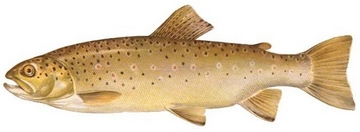The Brown Troutposted on 14 February 2015 | posted in Hints and TipsCommon name: Brown trout (sea trout) Latin name: Salmo trutta  Record weight: Natural record is 25lb 5oz 12 drams, captured in 1996 from Loch Awe. Larger fish have been artificially reared and the cultivated record now stands at over thirty pounds. Distribution: Brown trout are amongst the most widespread of all freshwater fish, perhaps only second to the carp. Brown trout were originally limited to Northern Europe and North America, but have been transported around the globe by man, both as a sporting fish and for food. Today, brown trout is amongst the most heavily cultivated of fish with large scale farms being found in many areas. Brown trout can be found throughout the freshwaters of the British Isles and Ireland and also in coastal waters. Features: Although they have a dark colour, the rather dour common name of Salmo trutta belies a fish that is covered with small spots of many different hues of red and blue. Trout that migrate into coastal waters, commonly known as sea trout, are much paler in colour, almost silver in appearance, and can even be mistaken for salmon. Diet: Brown trout have a very wide ranging diet and will take anything from tiny invertebrates to small fish. The bulk of the diet of trout is made up of small invertebrates, particularly mayfly nymphs and caddis fly larvae. The larger sea trout tend to feed upon small fish, particularly young herring and sand eels. The largest lake trout, known as ferox, become almost solely fish eaters, following the huge shoals of artic charr found in the huge ice-age lakes of Northern England and Scotland. Spawning: All trout must return to small streams with clean gravel to spawn. Spawning tends to take place in September and October as water temperatures are beginning to fall for the Winter. The female digs a shallow redd into which the eggs are deposited. The eggs take approximately 150 days to hatch, the longest time of any British freshwater fish. The young fish spend at least a year in the natal stream before moving downstream to the sea or into lakes. Growth: The growth of trout is very dependant upon the environment. In small streams, brown trout may grow to no more than twelve inches in length and weigh less than a pound. Size is determined by the amount of food available and the size of the stream. A large fish in a small stream would struggle to find enough food and would be easy prey to terrestrial predators, like herons, so they stay small. In lakes and the coastal zone, food is much more available and there is much more room for the fish. In these environments, growing large is an advantage when trying to avoid predatory fish and so the trout grow as quickly as possible. Sea trout may reach five pounds in only five years and the largest fish may live for twenty or more years before returning to their home streams. |








.jpg)
.jpg)





